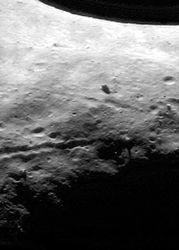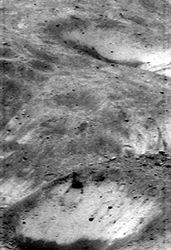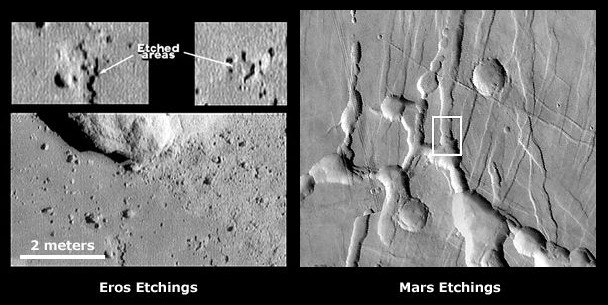EROS not so Mysterious
by Wal Thornhill | February 10, 2001 6:42 am
The following message is from Reuters:
On February 12, the world’s first spacecraft will land on an asteroid – Eros, named after the Greek god of love – and stream a series of photographs in nearly real time. That equates to two images a minute, which will be streamed to the Web site www.near.jhuapl.edu At more than 196 million miles from Earth, the asteroid will be the most distant object on which a spacecraft has landed.
The event is the grand finale of a one-year orbital mission of Eros, the first of NASA’s Near Earth Asteroid Rendezvous (NEAR) program, whose goal has been to determine Eros’ mineralogical make-up and its relationship to comets, meteorites and the origin of the solar system.
The Result?
The NEAR web site Science Update December 28, 2000 is headlined:
More Mysteries
We are planning to devote the last two months of the mission to low altitude observations. What we have seen so far in the low orbits has merely whetted our appetite for more. We went up close to have a better look at the surface than ever before, but we now see things we do not understand, and we need more information. That has been the story of the NEAR mission, and that is why we are going back to low orbit despite the rough ride that the irregular gravity field of Eros will give us.
The craters on Eros provide several examples of mysteries that we are working on. Craters are the records of impacts that have largely shaped the surface of Eros, of other asteroids we have seen, and of objects from Mercury to the moons of Neptune. From the beginning of the mission, we saw two large concavities on Eros, for which we have proposed the names Himeros and Psyche. In the early images Himeros appeared saddle-shaped, and we could not be sure if it was indeed an impact crater, but Psyche displayed from the start the classical bowl shape of an impact crater. Although it was not immediately apparent, Himeros was actually not saddle-shaped at all, but bowl-shaped. Careful mapping of its topography by the NEAR Laser Rangefinder and by the imager shows that as far as Eros’ gravity field is concerned, its depth is consistent with impact excavation. Still, if it is an impact crater, it is oddly shaped.
Another mystery is that the interior surface of Himeros is relatively smooth and much less heavily cratered than typical areas on Eros, and so it must be relatively young. The same is true for the interior of Psyche. However, the largest impact features on a body are most likely the oldest. Moreover, there is a third global scale depression on Eros that is actually larger than Psyche in diameter. We have proposed to name this third depression Shoemaker Regio, and it too may be an ancient, degraded impact crater or as many as three degraded craters side-by-side. The interior of Shoemaker Regio is young like the interiors of Himeros and Psyche, because it is lightly cratered, but it is also the most boulder-rich area on Eros and very different from the relatively smooth interiors of Himeros and Psyche.What has happened?
We do not know. Eros is a body without atmosphere or ocean, without large-scale volcanism (Eros has never melted completely, but some partial melting may have occurred in the past), and without plate tectonics, but it has ongoing geologic activity. What could be sculpting the surface except impacts? Much the same can be said for the Moon, although the Moon did have extensive magmatic activity (releases of lava on a global scale) billions of years ago. On the Moon, the primary process shaping the surface is cratering. In the lunar highlands, for example, we see that the continuing rain of projectiles has produced a state that approaches what we call “equilibrium saturation”, where each new impact on the average erases as many pre-existing craters as it makes new ones (each projectile makes a primary crater but can make additional craters if it produces ejecta that fall back to the surface at high speed). In the equilibrium state, we find that the density of craters on the surface obeys a characteristic relation. Namely, if we count craters of a given size range, say from 10 km to 14 km diameter in a certain region on the Moon, and we ask what is the total area covered by craters of this size in this region, we find empirically that about one fifth of the area is covered. The same is roughly true for craters in other size ranges (say from 20 to 28 km), as long as the minimum and maximum diameters of the size range stay in the same ratio, and provided that the craters are not too large. This distribution implies that the total number of craters smaller than some diameter scales roughly as the inverse square of this diameter, up to some maximum size. That is, the total number of craters smaller than 2 km is four times as many as the total number smaller than 4 km, and the number smaller than 1 km is four times as many again. Similar distributions are found on heavily cratered bodies throughout the solar system, although there are deviations from the simple power law that reflect the geologic histories of the individual objects.
The crater size distribution records how many projectiles of various sizes hit the Moon, which interests us because the distribution of projectiles that bombarded the Moon must also hit the Earth. Although there are complications – it is not completely straightforward to relate the distribution of craters to that of projectiles – this is why horrific impacts like the one at Chicxulub, which ended the age of the dinosaurs on Earth, are much less frequent than minor impacts like the one that made Barringer Meteor Crater (and we are thankful). This is also why the largest impact craters on a body, like Psyche or Himeros (if it is one), are likely to be the oldest. Larger impacts occur less frequently, so it is unlikely for a large impact to have occurred very recently. Moreover, large impacts create large volumes of ejecta and produce large seismic disturbances, both of which tend to erase small craters around them (by covering or obliterating them). A very large impact, like Psyche on Eros, may be able to erase small craters globally. Perhaps if Psyche formed after Himeros, it could have ‘reset’ the surface on Eros by erasing small craters, but then how was the interior of Psyche also reset?
In any case, when we saw heavily cratered surfaces on Eros, we were not surprised, and we expected an equilibrium saturation distribution to apply. However, the distribution of craters that we actually see at Eros is very different. An equilibrium saturation distribution would mean that if we are able to see smaller craters, we should find more of them, approximately as the inverse square of the size. This is not true at Eros. We went to low altitudes and looked for smaller craters, but found that craters below about a hundred meters in diameter are markedly depleted. Furthermore, the smaller the size of crater we look for, the fewer we find relative to what we would expect from an equilibrium distribution.
So, again we ask, what is happening? Perhaps it will not be us, but some future scientists, who will unravel some of the mysteries we are studying. In any case, we are working hard to understand the surface of Eros.
Andrew Cheng
NEAR Project Scientist
Comment:
The mysteries about the asteroid Eros begin the moment it is assumed that the history of asteroids is fairly well known. A great deal is made out of the so-called impact cratering record. But the story about the formation of the solar system from a disk of rubble is nothing more than a fable. And like any fable, disbelief must be suspended when a miracle is called upon at the end of each chapter to keep the story alive.
We don’t have to wait for future scientists to unravel the mysteries of Eros. It is almost 30 years since the publication of an electrical model of the solar system by the brilliant engineer from Flagstaff, Arizona – Ralph Juergens. Following his death in 1979, the Canadian physicist, Earl Milton, continued the work of his good friend. A simple version of the cosmic electricians’ story is that most comets, asteroids and meteoroids have a common origin. They are formed from material that has been electrically torn from an existing planet during a close encounter with another planet. The forces that melted, shaped and eroded the surface of an asteroid are those encountered in plasma arc machining. Milton and Juergens independently came to the same conclusion. In 1980, Milton wrote: “Likely the small body of the comet here functions as an undersized anode and evaporates like an electrode in an arc. Over time the cometary nucleus should become cratered and pitted like the surfaces of some of the planets and satellites of the Solar System. When a spacecraft finally achieves a rendezvous with one of the comets scientists are going to be surprised to find a surface pitted like that of the Moon, Mars, or Mercury.” The same statement applies to asteroids. The circular craters on Eros with smooth interiors are not due to impacts. The size distribution of craters is dependent solely upon the power of the cosmic lightning being endured by the body during its birth or during a cometary existence. And differences in cratering density have nothing to do with age of the surface. Electrical cratering takes place in a flurry and, as with the sunward side of a comet, may be selective in the areas struck.

Groovy Asteroid Images returned by NEAR Shoemaker show that Eros, like a number of other asteroids and asteroid-like moons, has a surface cut by linear troughs called “grooves.” Similar features have been identified on asteroids Ida and Gaspra and on Mars’ moon Phobos. However, the high-resolution images of Eros allow the origin of its grooves to be investigated in unprecedented detail.
This image showing several grooves was taken May 17, 2000, from an orbital altitude of 52 kilometers (32 miles). The whole scene is about 1.4 kilometers (0.8 miles) across, and shows features as small as 4 meters (13 feet).
Credit: NASA/JHUAPL
Grooves on asteroids are usually explained as evidence of structural faults. In fact, with their population of craterlets they are to be seen wherever electrical arcing has been widespread on a surface. They often form parallel patterns and are caused when powerful electric currents travel along the surface. The filaments of current exhibit long range attraction and short range repulsion, which creates parallel grooves. Eros has such features which have been compared with a wood-grained appearance. The on-channel craters are formed where the intense surface heating creates sufficient charge carriers to be the focus of a short-lived arc.
Comets and asteroids are the same bodies, distinguished only by their orbits. Asteroids occasionally show a diffuse cometary appearance and one asteroid, Chiron, was observed in 1988 to become a comet. An asteroid will become a comet if its orbit becomes highly elliptical. Any large object, including a planet, will find a rapidly changing electrical stress as it moves radially with respect to the Sun. The result is the formation of a Langmuir plasma sheath to enclose the charged body’s alien electric field. That is what forms and and stabilizes the huge comet comas that may have a visible diameter of a hundred thousand kilometres. There is no way that the puny gravitational field of a 10km rock can control that volume. The close up image of the nucleus of comet Halley, snapped by the Giotto spacecraft as it flew by, shows the kind of electrical surface machining that shapes asteroids. The nucleus cratering and presence of x-rays and energetic particles near a comet were all predicted by Milton years before the Halley encounter in 1986.
The electrical model of the solar system has implications for the NEAR spacecraft as it attempts to softly crash-land on the asteroid. An electrical discharge between NEAR and Eros may occur even though the spacecraft has had a year to slowly equalize its voltage with that of the asteroid. If that happens, the signal from the spacecraft may disappear before touchdown. Once down, and if still functioning, dust could electrostatically coat the lenses of the cameras. The state of surface material in the form of dust, soil and boulders, will be determined by the asteroids history. It is more likely to have loose surface material if the asteroid has not had a cometary history since its formation. The many boulders on Eros hint that this is so. Small craters on the Moon were seen by the Apollo astronauts to contain glassy deposits at their centers. They are the equivalent of fulgurites formed by lightning in sand. With luck a close up of the small craters may show evidence of glass. The place to look is the enigmatic light colored filamentary deposits which are reminiscent of the light colored rayed-craters on the Moon. Such rays, Juergens showed, are electrical in origin.
 A Lacework Surface With the Sun high in Eros’ sky, shadows disappear and bright surface features stand out. In this picture taken by NEAR Shoemaker on July 19, 2000, from an orbital altitude of 36 kilometers (22 miles), the Sun is nearly overhead. The steep local slopes are hard to see without shadows, but the lacework of bright and dark regolith is at its most conspicuous. The image shows a region about 800 meters (2,600 feet) across. The smallest visible rocks are about 6 meters (19 feet) across.
A Lacework Surface With the Sun high in Eros’ sky, shadows disappear and bright surface features stand out. In this picture taken by NEAR Shoemaker on July 19, 2000, from an orbital altitude of 36 kilometers (22 miles), the Sun is nearly overhead. The steep local slopes are hard to see without shadows, but the lacework of bright and dark regolith is at its most conspicuous. The image shows a region about 800 meters (2,600 feet) across. The smallest visible rocks are about 6 meters (19 feet) across.
Image Credit: NASA/JHUAPL
Congratulations to the engineering team of NEAR for a highly successful mission.
Science has a long way to catch up!
POSTSCRIPT:
Near has made a historic landing on Eros. And 69 detailed pictures were taken during the last 5 kilometres descent. The closest was from a height of only 120 metres showing features down to 1 centimetre across. In a press conference on 14 February, Dr Joseph Veverka said, “These spectacular images have started to answer the many questions we had about Eros, but they also revealed new mysteries that we will explore for years to come.” One of those mysteries was an area “where the surface appears to have collapsed.” They are shown here in the insets above the closest image taken of Eros.
The argument of surface collapse is well worn, having been used to describe similarly etched areas of Mars. There it is attributed to subsurface liquid flows. It doesn’t work on Mars, so to use it as an explanation on an asteroid is a sign of desperation. The simple answer is that it is electric arc erosion. The left hand closeup image shows the usual sharp, rounded edges and flat floor of spark machining craters. Electric discharge phenomena are scaleable over a huge range so that it is acceptable to compare erosion on a surface under a microscope with landforms on Mars that stretch over hundred’s of kilometres. It seems entirely appropriate on Valentine’s day that Eros should be showing us his etchings!

Source URL: https://www.holoscience.com/wp/eros-not-so-mysterious/